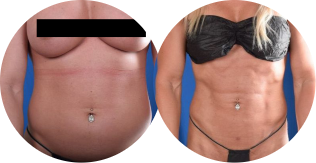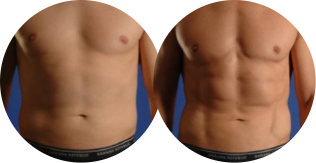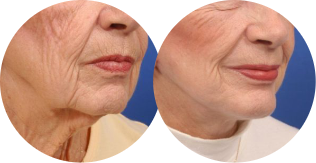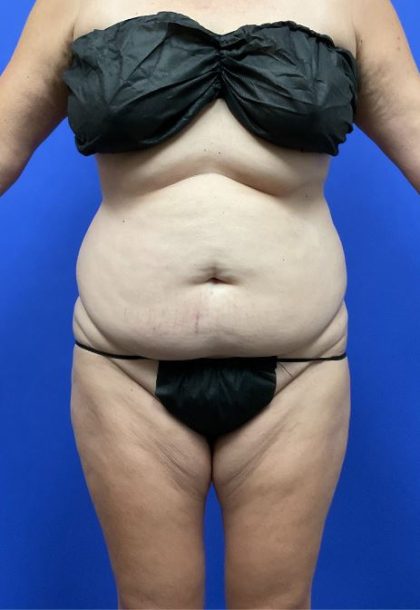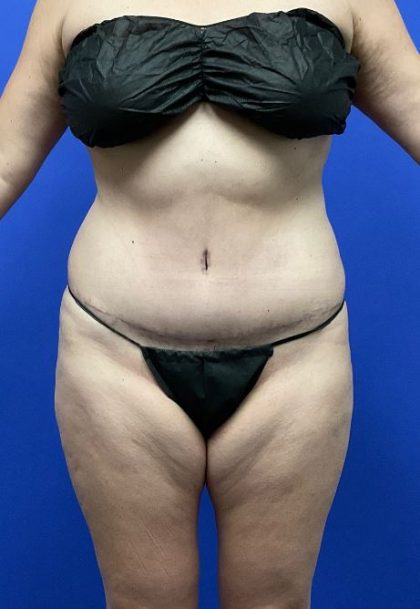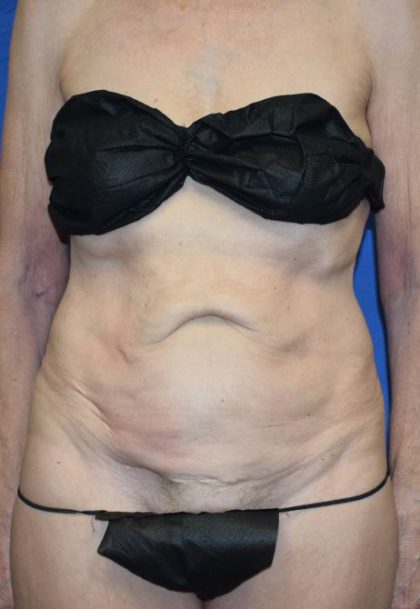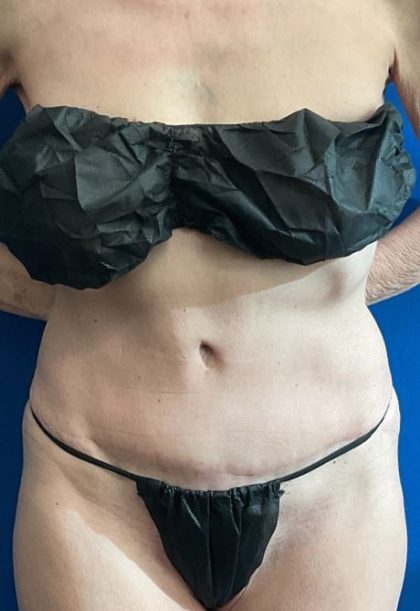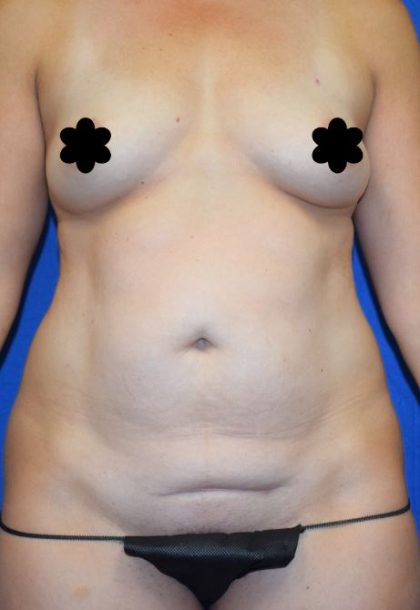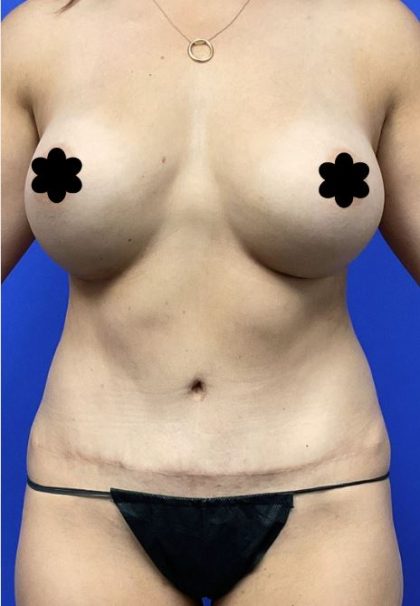Tummy Tuck
Offered at our convenient location in Denver

A Tummy Tuck, also known as an ‘Abdominoplasty’, is the fourth most popular cosmetic surgery for women. Only breast augmentations, liposuction and eyelid surgeries are more popular.
Abdominoplasty’s are also becoming increasing popular with men.
Tummy Tucks remove excess fat and skin while restoring weakened or separated muscles which create an abdominal profile that is smoother and firmer. A flat, well-toned stomach is what many women strive for.
Unfortunately, you won’t always achieve your goals through diet and exercise. Even individuals with a healthy BMI can develop an abdomen that is loose and sagging.
Contents
Before and After Photos
Things You May Not Know About Abdominoplasty
- Results of a tummy tuck can be diminished by significant fluctuations in weight.
- If you are planning to lose additional weight, you are advised to postpone a tummy tuck.
- If you are considering future pregnancies, you are advised to postpone your tummy tuck.
- A tummy tuck cannot correct stretch marks, although some may be removed or improved if they are located on the areas of skin that will be taken out.
How To Tell If You Need A Tummy Tuck
Many of our patients who want to address sagging or excess fat around their abdominal area are unsure if they need liposuction or a tummy tuck to achieve their body goals. Are you unsure whether you should go with a tummy tuck or liposuction? Try a Diver’s Test.
A Diver’s Test is an easy, at-home check you can perform on your own that will help you
determine if your body would be better served with a tummy tuck, liposuction or both.
How to Perform a Diver’s Test
- With your shirt, bra and pants off, stand up straight. (It is important to avoid any clothing that might hold up or tighten your body artificially during this test)
- Wrap your arms behind your back.
- Bend your waist until your upper body is at a 45 degree angle.
- Observe the amount of sagging or hanging skin on your abdominal area.
- You may need a tummy tuck with liposuction if you notice a significant amount of skin folding and moving forward, or hanging downward.
To truly know which option is best for your body, an in-person consultation with Dr. Millard will answer any questions you may have.
Types Of Tummy Tucks
The amount of excess skin and the amount of fat will determine what type of tummy tuck is best for you.
VASER Hi Def (Full) Abdominoplasty
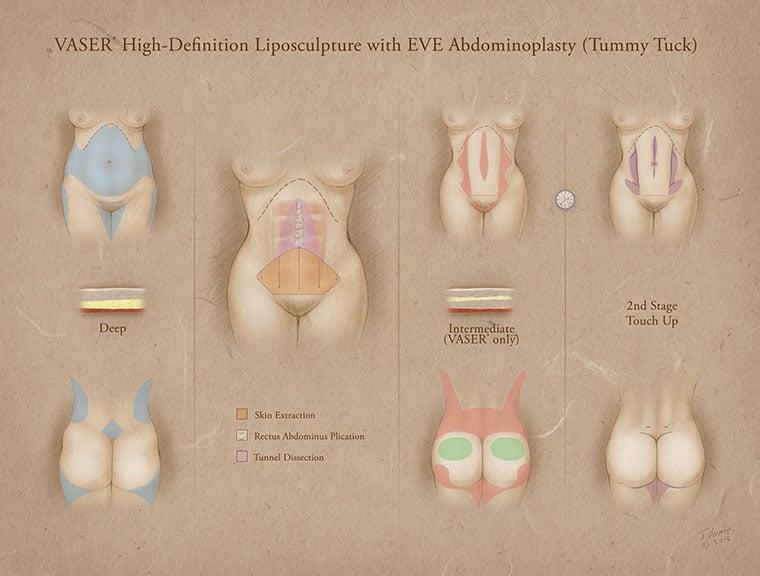
Utilizing the “Avelar” Method from Brazil adding Dr. Millard’s pioneering technique of VASER Hi Def LipoSculpture to achieve a feminine, yet athletic appearence in women and a chiseled appearance in men, while at the same time tightening the your abdominal muscle and removing your extra skin.
Full Abdominoplasty
An incision is made from hip to hip just above the pubic area and another incision is made to free the navel from surrounding skin. The skin is detached from the abdominal wall to reveal the muscles to be tightened.
Liposuction is often used to refine the abdominal sculpture, much like a corset. Technique options as part of the complete abdominoplasty include “High Lateral Tension Technique” and “Avelar Technique” as a modification to the standard abdominoplasty technique.
VASER Hi Def Partial (Mini) Abdominoplasty
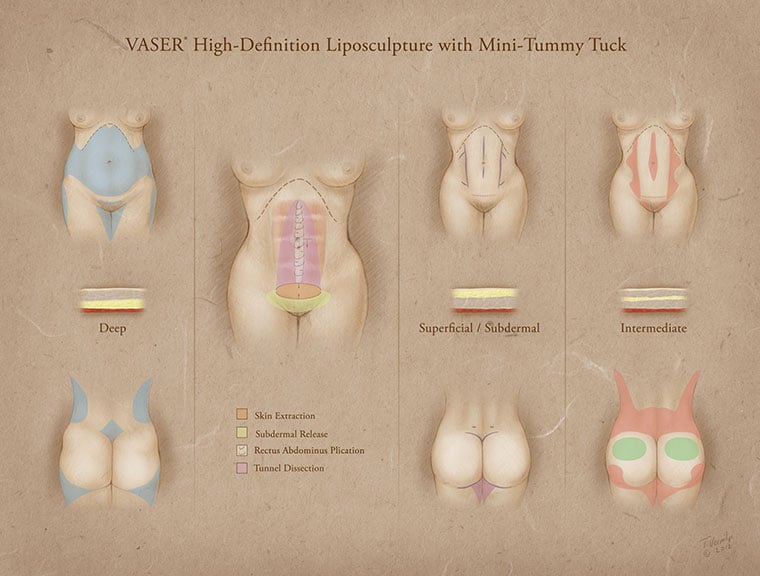
Utilizes Dr. Millard’s pioneering technique of VASER Hi Def LipoSculpture to achieve a feminine, yet athletic appearence in women and a chiseled appearance in men, while removing your extra skin.
Partial (Mini) Abdominoplasty
An incision is made and skin and fat only below the belly button are removed. The resulting scar is usually slightly smaller that the scar from a full tummy tuck.
Extended Abdominoplasty
A full abdominoplasty plus a lateral flank lift. The procedure does all of the abdominal contouring of a complete abdominoplasty and allows further improvement of the waist and the sides or lateral flanks. This procedure is more common in patients who have had significant weight loss.
If there is significant excess abdominal skin, common with massive weight loss, an Extended Abdominoplasty might be recommended.
Circumferential Abdominoplasty
An extended abdominoplasty plus a buttock lift. The resulting scar runs all the way around the body, and the operation is also called a Belt Lipectomy or Body Lift.
This procedure is most common for patients who have lost a massive amount of weight. Dr. Millard does this procedure in stages, for both safety reasons and in order to achieve better results than can be obtained with a single stage procedure.
There has been a lot of plastic surgery papers published in recent years that recommend that plastic surgeons limit the amount of surgery especially liposuction outside the area of the abdomen, and especially avoiding liposuction in the lower extremity at the same time as abdominoplasty due to the increased risks of DVT (Deep Venous Embolism) and PE (Pulmonary Embolism).
Combination Procedures
Dr. Millard avoids doing several procedures at the same time as full abdominoplasty for safety reasons.
- Lower or upper extremity liposuction
- Additional contouring
- Breast reduction
- Breast lift
However, a Breast Augmentation and/or Buttock Augmentations are possible at the same time as a full abdominoplasty. This includes with use of implants or using the patients own fat. These procedures have proven to be safely done in conjunction with full abdominoplasties.
— A popular name for breast enhancement procedures performed in conjunction with an abdominoplasty is a “Mommy Makeover“.
Surgical Techniques
Dr. Millard will make a recommendation for one of the six different types of Tummy Tucks discussed above. He will then chose from one of the four techniques part of an advanced technique to be used to improve safety, allow him to add liposuction as part of the procedure and to help speed recovery and possibly eliminate the need for drains.
Standard Full Abdominoplasty Technique
The skin and fat are surgically separated from the abdominal musculature up to the level of the rib cage.
This technique is often reserved for patients who have no fat or have had previous tummy tucks or previous abdominal liposuction with significant scarring.
- Drains have to stay in longer
- Higher risk of skin healing problems
It is very risky to perform liposuction as part of the “Standard Full Abdominoplasty Technique.”
To be able to perform liposuction on the abdomen at the same time as the tummy tuck, it is highly recommended that Plastic Surgeons use an advanced technique and modification to their patient’s tummy tuck by using either a “High Lateral Tension Technique” or an “Avelar Technique.”
Dr. Millard is trained in both of these techniques and commonly performs them as part of a Tummy Tuck procedure.
High Lateral Tension Technique
An advanced technique and modification to the “Standard Full Abdominoplasty Technique.”
In addition to vertical-line muscle tightening, the upper abdominal connective tissue remains attached to the muscles underneath.
- Decreased risk of wound healing
- Less time for drains
- Liposuction can be performed
Liposuction is unsafe when doing the Standard Full Abdominoplasty Technique. Dr. Ted Lockwood originally pioneered this technique and personally trained Dr. Millard.
Avelar Technique
An advanced technique and modification to the “Standard Full Abdominoplasty Technique.”
In addition to vertical-line muscle tightening, the upper & lower abdominal connective tissue remains attached to the muscles underneath.
- Decreased risk of wound healing problems
- No drains
- Liposuction can be performed
- Excess skin removal limitations
If there is too much skin Dr. Millard will often recommend the “High Lateral Tension technique” over this technique.
Floating Abdominoplasty Or FAB Technique
This new technique, also known as an extended mini abdominoplasty, allows for tightening and shaping through a smaller incision that isn’t placed around the belly button.
The muscles are reshaped and tightened from sternum to pubic area. The skin is then tightened and the belly button is reattached.
Before and After Photos
Candidates
Good Tummy Tuck Candidates Are:
- Healthy
- At a stable weight
- Have realistic expectations
- Non-smoker; patients must stop smoking 90 days before a full abdominoplasty can be performed. This decreases the risk of the lower abdominal skin dying.
- Unhappy with their abdomen
Cost
Tummy Tuck costs can vary greatly depending upon your unique situation, amount of excess skin, amount of fat, estimated length of surgery, etc.
Tummy Tuck Surgery Cost Includes: A full quote will be provided after the evaluation portion of the consultation.
- Anesthesia fees
- Renewal Surgery Center fees (Premier CO Plastic Surgery Center 100% dedicated to Plastic Surgery)
- Post-Operative garments — Used only on mini-tummy tucks when flank or back work has been dome as well
- Surgeon fees
Recovery
Dr. Millard does not use any garments as part of the abdominoplasty recovery; something he learned from the world-renowned tummy tuck surgeon, Dr. Ted Lockwood.
Small thin tubes will temporarily be placed under your skin to drain out any excess fluid or blood. In some cases, no drains are required at all.
You will receive specific instructions for your particular tummy tuck recovery.
It is very important you follow these instructions to enjoy premium results.
Risks
Although Tummy Tucks are considered safe, like all other surgeries, complications may arise.
- Anesthesia risks — Dr. Millard has used the same Anesthesiologists’ for years.
- Blood clots, Thrombosis,Cardiac and/or Pulmonary complications– Dr. Millard is published in blood clot prevention and he uses the latest technologies in their prevention, including the use of postoperative Lovenox (A blood Thinner) and he was among the first to send his patient home with portable SCD’s (Calf squeezers) that help decrease the risk of blood clots.
- Fluid accumulation — Use of the “High Lateral Tension” and “Avelar” Techniques significantly decreases risk of this.
- Numbness
- Asymmetry
- Skin discoloration
- Infection –Dr. Millard uses an aggressive preoperative protocol, similar to those used by orthopedic surgeon with their joint replacement operations, to minimize this risk. He also recommends use of Probiotics in all of his patients to help decrease this risk as well.
Majority of abdominoplasty risks can be avoided if you follow the post-operation instructions from your surgeon.
